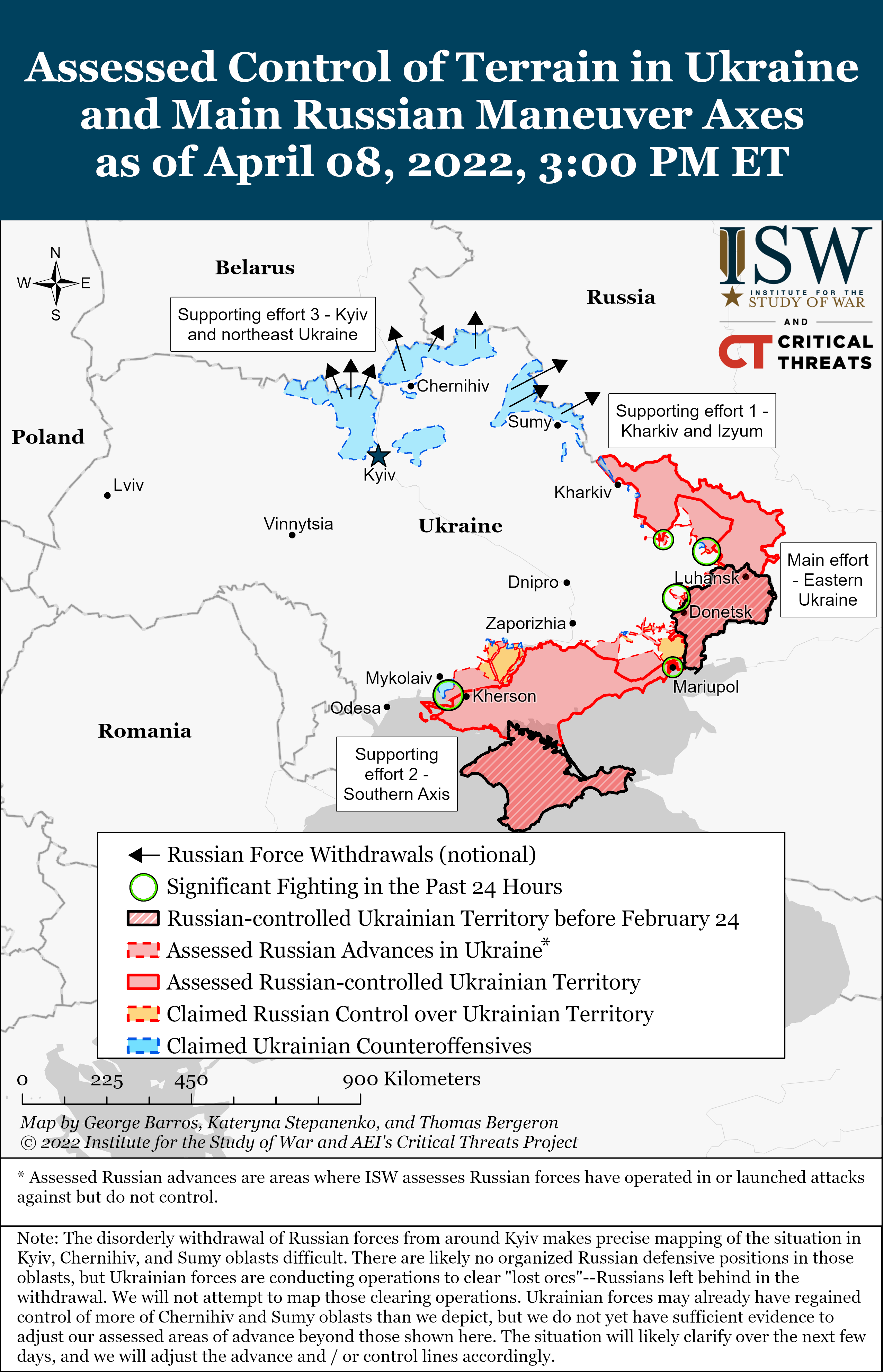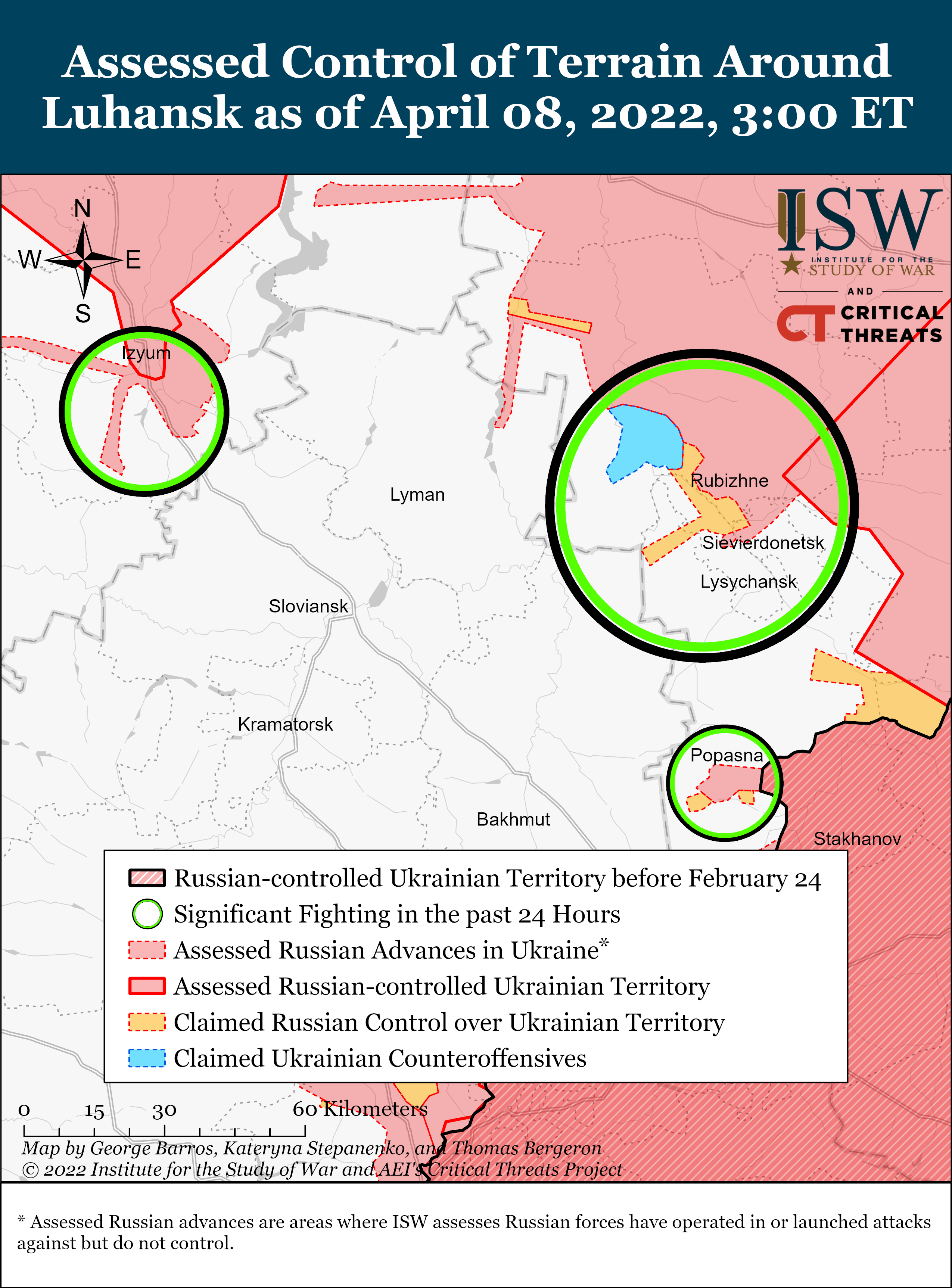RUSSIAN OFFENSIVE CAMPAIGN ASSESSMENT, APRIL 8
Immediate items to watch
- Russian forces will continue reinforcing the Izyum-Slovyansk axis and attempting to advance to and through Slovyansk to encircle Ukrainian forces.
- Russia is likely cohering forces in Donbas to attempt a major offensive in the coming days or weeks.
- The Battle of Mariupol continues, and it is unclear how much longer the Ukrainian defenders can hold out.
- Russian forces have fully vacated the Sumy axis and are regrouping in Belgorod for likely deployment to the Izyum-Slovyansk axis.
- Some Russian forces are likely to return to home stations in Russia while others will re-enter the fighting in the east.
Ukrainian forces retain control of defensive positions in eastern and southwestern Mariupol, despite Russian claims to have captured most of the city. ISW was able to confirm the specific locations of ongoing Russian assaults on April 8 for the first time in several days. Russian forces continue to attempt to regroup and redeploy units withdrawn from northeastern Ukraine to support an offensive in eastern Ukraine, but these units are unlikely to enable a Russian breakthrough and face poor morale. Russian forces along the Izyum-Slovyansk axis did not make any territorial gains in the last 24 hours. Ukrainian counterattacks toward Kherson continue to threaten Russian positions around the city.
Key Takeaways
- Ukrainian forces continued to hold out against Russian assaults in areas of southwestern and eastern Mariupol, notably in the port and the Azovstal Metallurgy plant, respectively.
- Ukrainian forces continued to repel daily Russian assaults in Donetsk and Luhansk Oblasts.
- A Russian Tochka-U missile struck a civilian evacuation point at the Kramatorsk rail station in eastern Ukraine, killing at least 50 and wounding around a hundred evacuees.
- Russian forces continued attacks south of Izyum toward Slovyansk and Barvinkove but did not take any new territory.
- Ukrainian counterattacks have likely taken further territory west of Kherson, threatening Russian control of the city.
Russian forces are increasingly refusing to reenter combat, and the Kremlin remains unlikely to quickly redeploy effective forces from northeastern Ukraine to operations in Donbas. The Ukrainian General Staff reported that more than 80% of personnel in some unspecified Russian units previously involved in combat operations are refusing to return to the front.[1] Russian commanders are reportedly refusing to release soldiers whose service contracts have expired, forcing them to stay with their units. The Ukrainian GUR (Military Intelligence) claimed to have intercepted a letter from Russian Chief of Missile Troops and Artillery Mikhail Matveevsky to several Russian training centers calling for further censorship of troops undergoing training, and encouraged propaganda highlighting the monetary benefits of serving in the war.[2] Elements of Russia’s 6th Combined Arms Army (CAA), 20th CAA, 1st Guards Tank Army, and coastal troops of the Northern and Baltic Fleets continue efforts to regroup for likely redeployment to eastern Ukraine.[3] The General Staff additionally reported that Russian Western Military District Commander Colonel General Alexander Zhuravlev (the first explicit mention of Zhuravlev since the war began) is planning to remove Major General Ivan Belyavsky from the position of the head of the WMD personnel department due to low recruitment numbers.[4]
We do not report in detail on Russian war crimes because those activities are well-covered in Western media and do not directly affect the military operations we are assessing and forecasting. We will continue to evaluate and report on the effects of these criminal activities on the Ukrainian military and population and specifically on combat in Ukrainian urban areas. We utterly condemn these Russian violations of the laws of armed conflict, Geneva Conventions, and humanity even though we do not describe them in these reports.
ISW has updated its assessment of the four primary efforts Russian forces are engaged in at this time:
- Main effort—Eastern Ukraine (comprised of two subordinate supporting efforts);
- Supporting effort 1—Kharkiv and Izyum;
- Supporting effort 2—Southern axis;
- Supporting effort 3—Sumy and northeastern Ukraine.
Main effort—Eastern Ukraine
Subordinate main effort—Mariupol (Russian objective: Capture Mariupol and reduce the Ukrainian defenders)
Ukrainian forces continued to hold out against Russian assaults in areas of southwestern and eastern Mariupol as of April 8. The Ukrainian Mayor of Mariupol, Petro Andryushenko, issued a statement on April 8 denying Russian claims that they captured central Mariupol on April 7.[5] Andryushenko said Russian forces control a quarter of the city, including the Drama Theater and SBU headquarters, but that this does not constitute the entire “city center.” Andryushenko highlighted that most videos of Russian forces have been geolocated to Mariupol’s outskirts and said Ukrainian forces control the Primorsky District (southwest Mariupol), part of the east bank of the Azovstal District (central Mariupol), the coastline southwest of the city down to Azovs’ke, and several factory areas.
Social media footage depicted Russian and proxy forces conducting assaults on the Azovstal Steel Plant from April 7-8 and pro-Russian sources claimed 3,000 Ukrainian forces remain in the facility, confirming that Ukrainian forces retain a foothold in eastern Mariupol, which Russian forces previously claimed to have captured.[6] Ukrainian forces additionally released footage geolocated to eastern Mariupol of combat with Russian forces on April 8.[7]
Subordinate main effort—Donetsk and Luhansk Oblasts (Russian objective: Capture the entirety of Donetsk and Luhansk Oblasts, the claimed territory of Russia’s proxies in Donbas)
Ukrainian forces continued to repel daily Russian assaults in Donetsk and Luhansk Oblasts. The Ukrainian General Staff stated Ukrainian forces repelled seven Russian attacks in the past 24 hours and claimed to destroy four tanks, two artillery systems, and 11 vehicles.[8] Russian forces remain concentrated on taking Rubizhne and Popasna in Luhansk Oblast and concentrated on Marinka in Donetsk Oblast.[9] Ukrainian military and civilian officials continued to warn that Russian forces are massing troops for a major offensive in eastern Ukraine.[10]
A Russian Tochka-U missile struck a civilian evacuation point at the Kramatorsk rail station on April 8, killing at least 50 and wounding around a hundred evacuees.[11] Russian attempts to deny the strike are completely false. Pro-Russian Telegram channels and the Russian Ministry of Defense initially claimed Russian forces conducted precision strikes on railway stations in Donbas before deleting the claims once heavy civilian casualties emerged.[12] Russian and DNR sources claimed both that the strike did not occur and that Ukrainian forces launched the strike as a false flag, ludicrously claiming that Russian forces do not use the Tochka-U missile—despite the fact Russia designed the Tochka, has demonstrably used it in previous strikes, and confirmed reports that Russia’s 8th Combined Arms Army (operating in Donbas) is equipped with the missile.[13]
Supporting Effort #1—Kharkiv and Izyum: (Russian objective: Advance southeast to support Russian operations in Luhansk Oblast, and fix Ukrainian forces around Kharkiv in place)
Russian forces continued to shell civilian infrastructure in Kharkiv and its outskirts on April 8.[14] The Ukrainian General Staff additionally reported that Russian forces are establishing minefields around Kharkiv in expectation of Ukrainian counterattacks.[15]
Russian forces continued attacks south of Izyum toward Slovyansk and Barvinkove on April 8 but did not take any new territory.[16] Local authorities continued to urge civilians to evacuate the area.[17]
Supporting Effort #2—Southern axis: (Objective: Defend Kherson against Ukrainian counterattacks)
Ukrainian counterattacks have likely taken further territory west of Kherson, threatening Russian control of the city. The Ukrainian General Staff reported that Russian forces launched unsuccessful counterattacks against Ukrainian positions west of Kherson on April 8.[18] A Canadian volunteer fighting with Ukrainian forces claimed on April 8 that his unit is fighting in Belozerka, 15km west of Kherson, but ISW cannot independently confirm this claim.[19] Mykolayiv Oblast Governor Vitaliy Kim said on April 8 that Russian forces only control Snihirvka (north of Kherson) in Mykolayiv Oblast, confirming previous reports that Ukrainian counterattacks have largely pushed Russian forces back into Kherson Oblast.[20] Kim stated that Russian forces continue to shell Mykolayiv and are attempting to spread fakes that they will attack Mykolaiv with thousands of tanks and 5,000 troops, which Russian forces do not possess in Kherson. Russian forces in the southern direction remain on the defense and continue to lose ground to effective Ukrainian counterattacks.
Supporting Effort #3—Sumy and Northeastern Ukraine: (Russian objective: Withdraw combat power in good order for redeployment to eastern Ukraine)
The Ukrainian General Staff confirmed on April 8 that Russian forces have completely withdrawn from Sumy Oblast, confirming reports from local civilian authorities on April 6.[21] Local authorities warned civilians to not return home and stay away from Russian equipment, much of which has been mined.[22] Ukrainian explosives disposal efforts will likely take weeks or months, with Ukrainian National Police Head Igor Klimenko stating on April 8 that Ukrainian forces have cleared more than 3,000 explosive devices from Irpin alone.[23] The Ukrainian General Staff reported that four Russian battalion tactical groups (BTGs) remain on the Ukrainian-Belarusian border to fix Ukrainian forces in place, though these forces remain highly unlikely to launch new offensive operations.[24]




